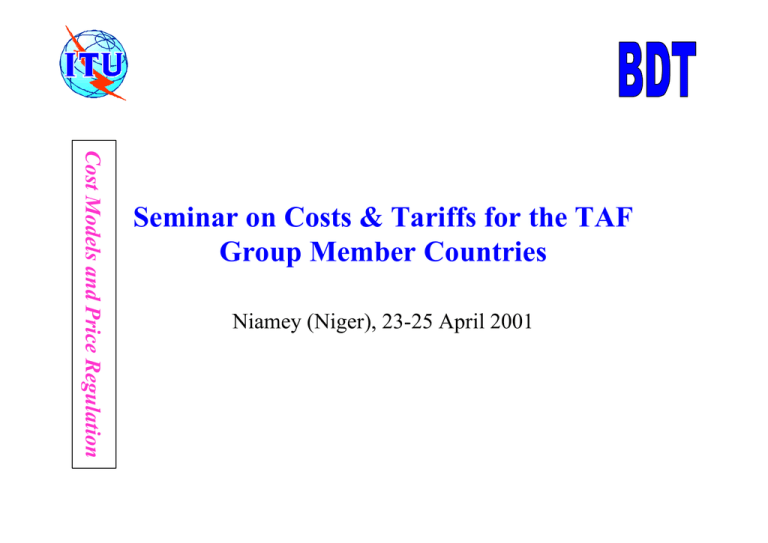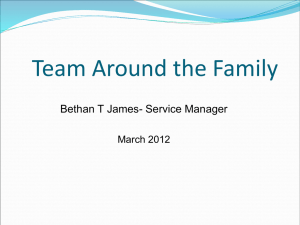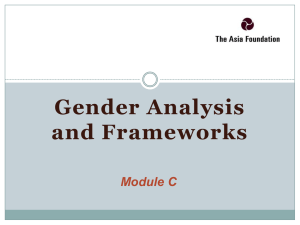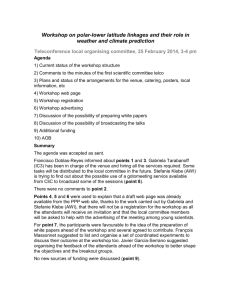Seminar on Costs & Tariffs for the TAF Group Member Countries
advertisement

Cost Models and Price Regulation Seminar on Costs & Tariffs for the TAF Group Member Countries Niamey (Niger), 23-25 April 2001 Cost Models and Price Regulation Use of Cost Models in Price Regulation Case of Price Cap regulation Pape Gorgui TOURE Price Regulation – Controls prices directly via “price cap” – Stimulates efficiency, promotes transition to competition – Consumers’ gain benefits of efficiency – Promotes investment, universal service goals – Incentive opportunity for improved earnings Price Regulation Experience • Residence line charges have remained level as telco efficiency gains have largely offset business cost rises • Per minute calling charges have fallen steadily, steady progress made in rate rebalancing, restructuring • Generally, telco PR earnings are higher as efficiency improves • Investment has risen and service quality remains high Price Regulation Concept • The PR annual pricing rules set the “Price Cap” limits for overall rates. This rule preserves the first share of telco productivity benefit to ratepayers. • Telco can improve earnings if it can be more efficient than previously under “cost plus” ROR regulation Price Regulation Plan – – – – – – – – – Annual Pricing Formula Annual Productivity Improvement Hurdle Service Basket Structure (service groups) Rate Change Flexibility ( rebalancing subsidies ) Adaptability to Competition (e.g. new services ) Administrative Streamlining Recovery of Exogenous (extraordinary) Cost Universal Service and Service Quality safeguards New Investment Incentives Price Regulation Concept • Productivity refers to how economically the firm manages its productive resources, capital, labor, materials etc.. • A total productivity measure, i.e. % efficiency improvement target for the telco, is used to limit overall price changes in most PR plans. • Productivity is an economic concept that can be gauged from past financial and operating reports. Price Regulation Concept • ‘Economies of Scale’ (EOS) lead to productivity gains. • Demand growth raises revenue but EOS causes costs per unit to fall so total cost rises more slowly. • But cost inflation raises unit and total costs • The price change limits in the plan recognize the past rate of telco price changes relative to past inflation in economy. % Productivity Hurdle (‘% X’) • Historical Telco productivity is volatile • The state of the economy directly affects productivity • Historical productivity studies can be contentious ‘black box’ exercises • Historical study results are only a starting point for an equitable productivity (% efficiency improvement) target. • “Unreasonable” productivity targets destroy incentives and deter new investment Price Regulation Rules Affect the Cost of Capital • McKinsey Consulting study indicates unduly burdensome or inflexible rules can reduce the “market value” of the telco from investors’ viewpoint. • “Unattractive” plan can raise cost of equity capital by 20% or more • Potential plan negatives: v Unreasonable efficiency improvement target (%X) v Unreasonable constraints on rate flexibility for incumbent vis a vis new competitors v Unreasonable burdens re subsidies, other service obligations PRICE REGULATION • COMMON EFFICIENCY IMPROVEMENTS – US: Annual 5% employment reductions for several years via: v attrition, early retirement incentives, job restructuring, department consolidations vwork outsourcing, e.g. cable installation vautomation, e.g. billing systems, self-service T-tone menus vfrom 45 employees per 10K access lines in 1990 to 26 now – UK: Employee levels declined steadily from 230K in 1984, only rising again to be at 217K recently Price Regulation • OTHER EFFICIENCY INITIATIVES – Performance bonuses, sales commissions, variable salary component based on achieving telco performance goals – broader merit-based salary bands – assessment, training, retraining programs – amnesty/recapture for prior disconnects but with restrictions such as toll blocking – spread out payments for initial non-recurring charges – dial-up 24 hour ‘self serve’ customer account and order acceptance – external performance benchmarking Cost Models and PR Cost Models and Price Regulation • A cost model can support price regulation in the following areas: – identify inefficient costs – simulate costs reductions effects – simulate the effect of future traffic growth • the combination of those allow easy calculation of a reasonable efficiency improvement target %X as defined below n n−1 n −1 n−1 P T = ( 1 + RPI − X ) * P ∑ i i n −1 ∑ i Ti i where: Pin =price of service n° i in year n Tin =traffic of service n° i in year n RPI = Price Reduction Index Cost Model and USO Cost Models and Price Regulation • Where a regulator opposes immediate tariff rebalancing, cost model will provide a measure of transferred charges (access deficit) and how it affects the efficiency improvement target: – additional constraints on the most important services basket (urban and interurban) – charges transferred to highly competitive (international), and sensitive (interconnection) services baskets TAF Model and efficiency Cost Models and Price Regulation • The TAF cost Model deals with inefficient costs as defined below: K ' = max(0; ∆K − K u [(1 + τ ) N − 1]) where: K ’ = the inefficient capacity; ∆K = the unused capacity; Ku = the capacity in use; t = the compound annual growth rate of the capacity in use N = the time needed to add new capacity Cost Models and Price Regulation • The inefficient cost in the TAF model are not allocated to the services provided to other operators (national and international); • in addition, the TAF model allows any simulation on the following operator expenses (OPEX): – intermediate consumption; – taxes & levies; – salaries & welfare – amortisation/depreciation ; – provisions • the model also allows simulations on capital expenses (CAPEX) through: – expected return on invested capital; – weighted average loans interest rate. • Any of cost those elements can be optimised in order to strengthen efficiency. Elasticity Cost Models and Price Regulation • When elaborating a long term business plan with efficiency constraints, using the TAF model tariffs, one must take into consideration the Price/Demand elasticity of the various services directly available to the public. • Elasticity has an effect on traffic volume and thus in unit cost of traffic, thus on %X determination. • Elasticity effect should be added to the natural growth trend of traffic and not substitute it; • its determination depends on the overall environment of a given market . Growth rate, elasticity and efficiency Cost Models and Price Regulation • The combination of the natural growth of users number (especially in low teledensity countries) and elasticity should lead to a growing traffic volume, thus an improved economy of scale. • Improvement of economy of scale are taken into consideration in the TAF model through: – geographical correction coefficient; – per service traffic volume identification %X determination Cost Models and Price Regulation The efficiency improvement target is calculated as follows: m ∑∑ Pi Ti j X = 1− j =1 i j −1 m − ∑ ( RPI j −1 ∑ Pi j−1Ti j−1 ) j =1 m ∑∑ Pi j−1Ti j−1 j =1 i i Where: RPIj-1 =Average Reduction Price Index m=Price Cap validity delay in years Pin =price of service n° i in year n Tin =traffic of service n° i in year n •Where price caps have to be set for different service baskets, only the services in a given basket will be considered. •Subsidised services should not be subject to price cap regulation as they are not cost based. RPI and exogenous costs Cost Models and Price Regulation • The RPI is different from and does not conflict with the currency loss of purchasing power defined in the TAF model; • its yearly future values estimation should derive from the official national economy projections. • Some cost are exogenous to an operator they must be recovered in total and are not included in the price regulation process; (ex.: outpayments of interconnection fees). END






